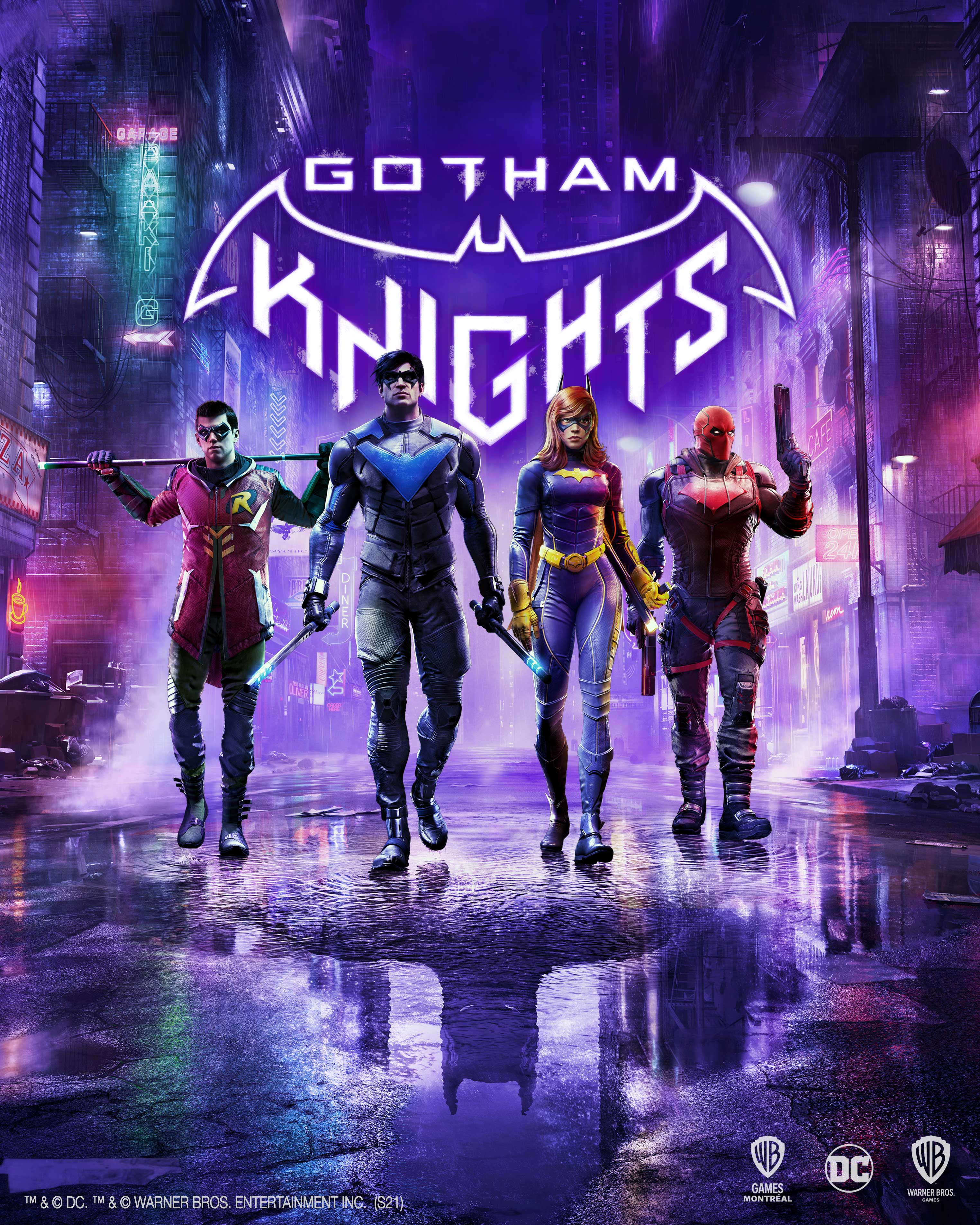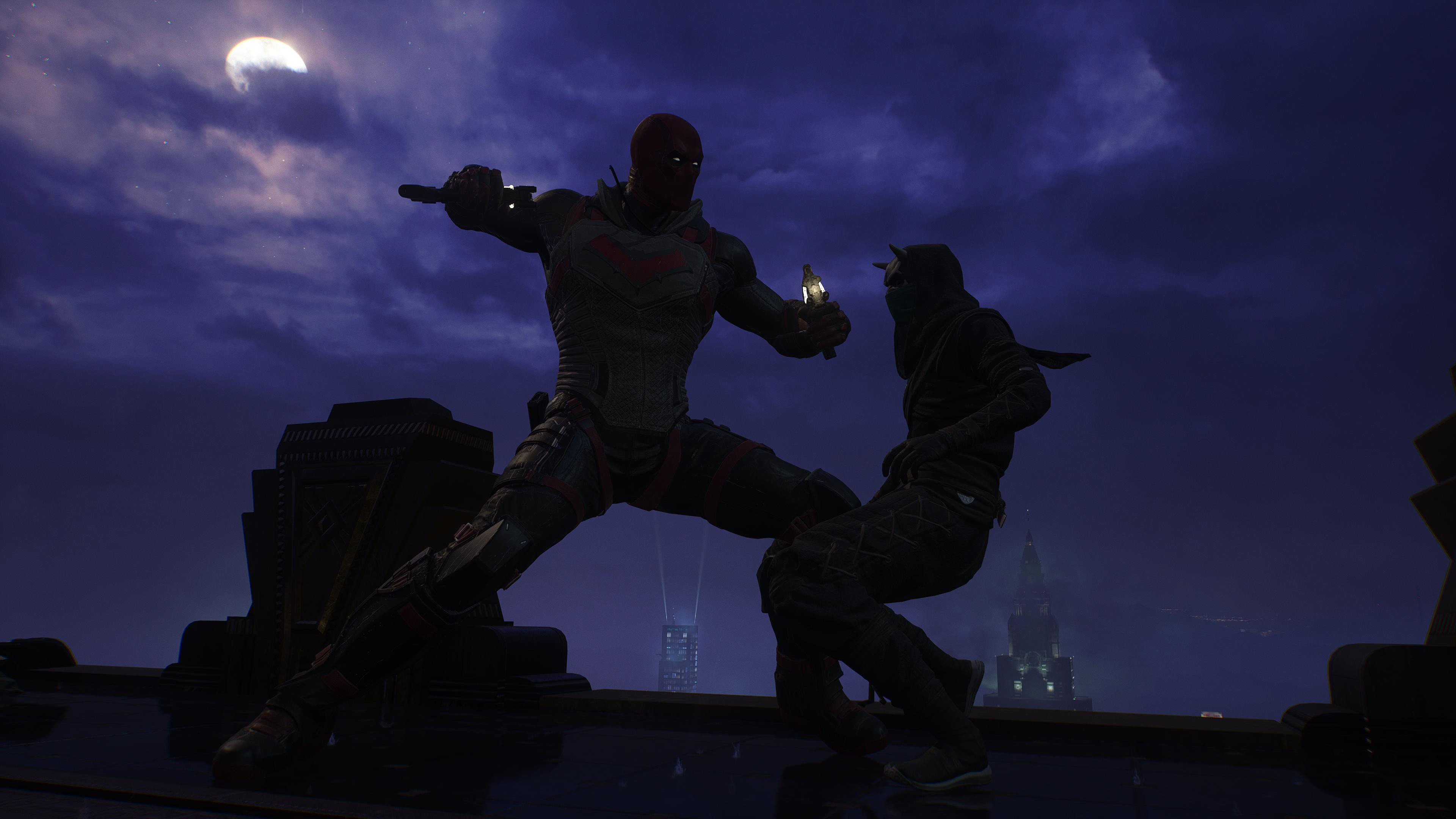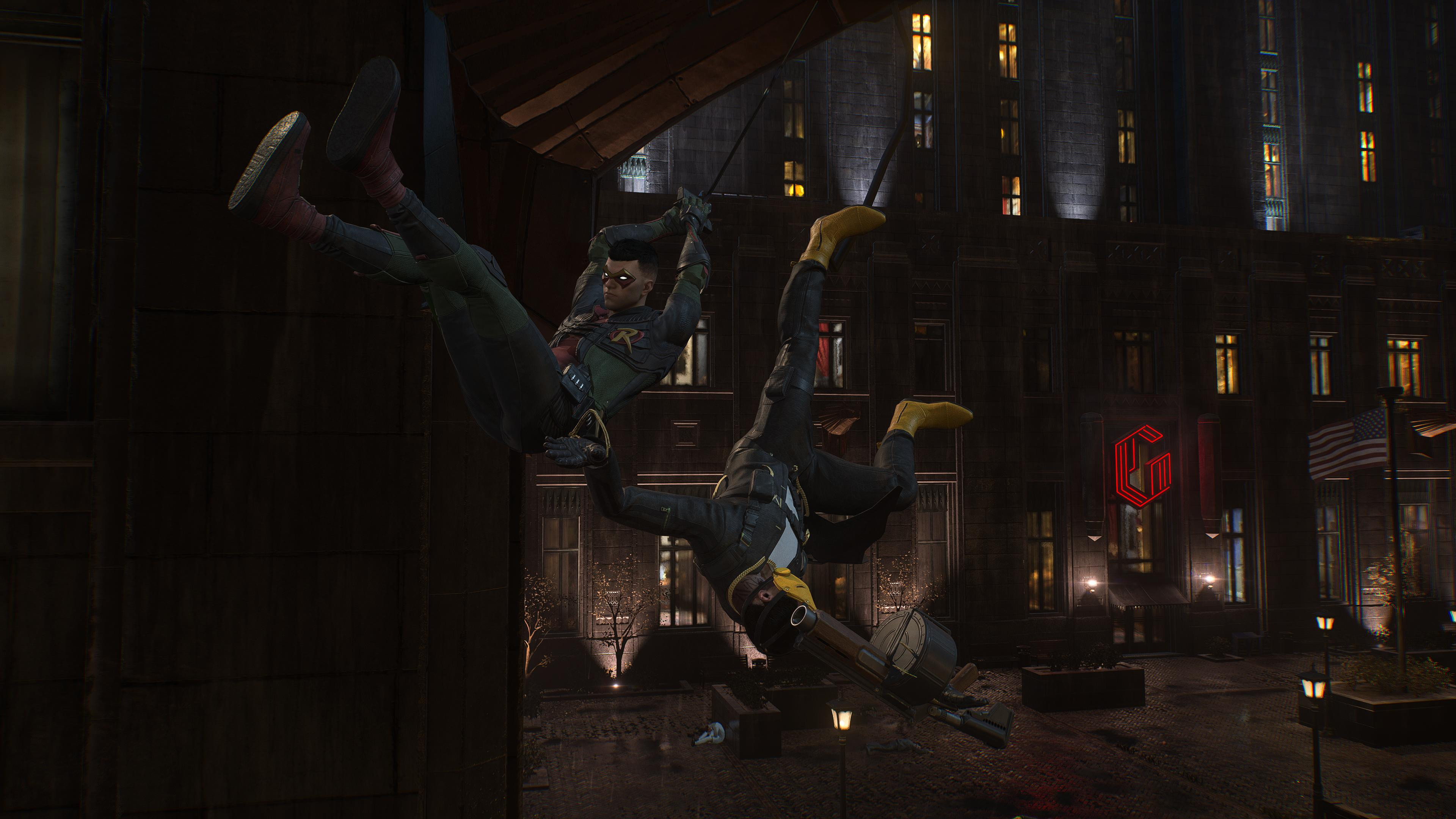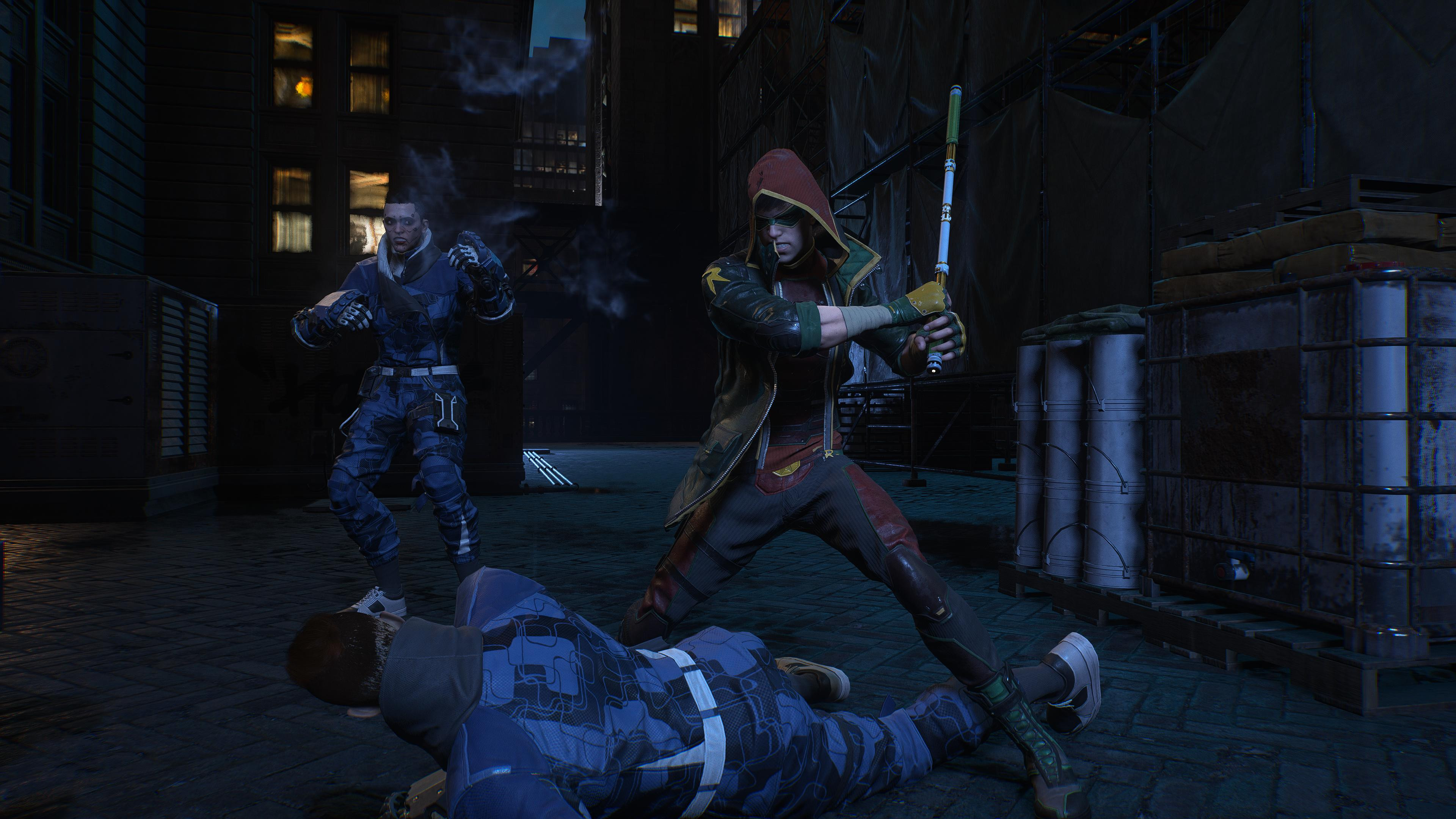
It has been nine long years since Warner Bros Montreal last released a game. Batman: Arkham Origins was the forgotten child, shoved to the side as people referred to the Arkham “trilogy” developed by Rocksteady. And while it was certainly true that Arkham Origins didn’t hit quite the same highs, Warner Bros Montreal still delivered a rock-solid Batman game. With that success, the future seemed bright for Warner Bros Montreal as they were primed to take over the Batman license while Rocksteady moved on to other things. But then they released the Batgirl DLC for Batman: Arkham Knight and…vanished. Reports of canceled projects such as an Arkham Knight sequel starring Damian Wayne and a Suicide Squad title threw the entire studio’s existence into question. Nine years is a long time for a studio to expend money without putting anything out. Here we are, though; Gotham Knights, a brand new Batman game that isn’t set in the Arkham universe, a chance for Warner Bros Montreal to don their cape and cowl again, an opportunity to prove themselves the heroes we deserve.
When you peel off the cowl, though, Gotham Knights is a confusing mess underneath with multiple identities vying for control. There’s a single-player Bat-family adventure colliding with a co-op experience, loot grinding, and a strong feeling that the whole game was once envisioned as a live service game and then re-tooled into its current form. The result is frustrating at times because of the many little design decisions that leave you scratching your head. After so long, Warner Bros Montreal’s big return is a gentle fizzle. Gotham Knights is not terrible, but it is disappointing.
Before we rappel into this bat-cave of a review, let’s establish exactly what Arkham Knights is. Despite the “Arkham” in its title, Arkham Knights is not actually a sequel to any of the prior Arkham games from Rocksteady or from WB Montreal’s own Origins. It exists in its own universe, its own timeline with its own history into which players are thrown. That could be a point of confusion for people whose experience of Batman is mostly limited to the games and the movies because characters like Jason Todd have a complex history that’s referred to but never explained. As a comic-book fan, I know his story, but even I’m unsure if Arkham Knight’s version of Todd is exactly the same. Was he killed by the Joker in this timeline? Or did something else happen? The writers are content to leave it a mystery, in the same way that the Joker’s weird absence is never explained, either. Don’t get me wrong, it’s probably a good thing that WB Montreal didn’t just dive straight into yet another Joker tale, but it’s more than a little odd that he isn’t even mentioned in a story featuring the death of Batman and two main characters who are inextricably tied to the Clown Prince of Crime. Does any of this ultimately matter to most people? Probably not. But it’s still worth having the context.
Available On: PS5, Xbox Series S/X, PC
Reviewed On: PS5
Developed By: Warner Bros Montreal
Published By: Warner Bros
I mentioned the death of Batman, so let’s get that out of the way. Arguably the best part of the entire game is its opening scene which lays the groundwork for the story. Battling against a classic foe, Batman is bruised, battered, and beaten. He sees just one answer to save his precious city and takes it. In the resulting chaos, Batman makes the ultimate sacrifice. The Dark Knight falls. Gotham is without its protector. So it’s up to the Bat family to step up: Nightwing, the original Robin and now the protector of Bludhaven; Barbara Gordon, the former Oracle and current Bat-Girl; Tim Drake, the newest Robin and the youngest of the group; and Jason Todd, formerly dead and now the Red Hood. With the Caped Crusader gone, these characters get their moment to shine in a videogame in a plot that uses one of the newest, most interesting creations from Snyder’s excellent run of Batman comics and pits them against another classic group.

The main plot isn’t anything too exciting, drawing from various different stories and wrapping up with a twist you’ll probably see coming a mile off. But it’s still solidly told with a couple of really fun moments. The real draw is getting to hang out with the Bat family, including a brilliantly acted version of Alfred Pennyworth. Of the group, it’s Nightwing who probably comes across as the dullest, simply because he’s already a full-fledged hero with slightly fewer hang-ups than some of his other teammates. The death of his father figure is obviously devastating and he does get an arc about trying to step up and become a leader, but it didn’t quite hit for me. Tim Drake fares better because he’s the youngest of the group who is now having to figure out life without Bruce while being a vigilante. But the two most interesting arcs come from Barbara and Jason. Barbara’s father, the iconic Jim Gordon, has already passed away in this version of the Batman universe, and now Bruce’s death leaves her reeling again. She also gets an intriguing arc that focuses on her photographic memory seemingly failing when it comes to remembering her dad’s face. Jason, meanwhile, is still dealing with the emotional trauma of having died, been resurrected in a Lazarus pit, brainwashed and used as a weapon, and then finally being rescued and reformed by Bruce. He’s angry and aggressive, a much bigger hothead than the rest of his adopted Bat family, and his story of trying to become the man Batman knew he could be is the one I found the most interesting.
Quite a lot of the best story moments come from optional character arcs, little cutscenes you can trigger within the Belfry that provide glimpses into the group’s dynamics, whether that’s the hulking Jason taking on Barbara in a dancing game or a more emotional moment with Alfred. They don’t all land, but the majority are fun, interesting and/or emotionally charged. No doubt comic purists won’t always like the way WB Montreal portray their versions of these established characters, but for the most part, I think they do a good job of delivering their own take while also retaining the general feel and tone of the original works.
However, the main storyline writing feels more…basic in many regards. Follow the main missions and it kind of feels like the characters get boiled down to their simplest traits and then repeat those traits over and over. Jason is a great example because almost every cutscene is basically him getting annoyed at the slow progress and then storming off while muttering something about busting some skulls. Tim and Barbara will invariably be the ones who figure out most of the actual detective work while Jason and Dick look both baffled and amused by their geekery. It’s fine in the first hour or two because it establishes the basics of who these people are, but as the story chugs along the character writing never quite keeps up. Perhaps a lot of those optional character moments (which you might miss anyway if you don’t swap characters) should have been weaved into the main story.

Overall, though, I had a good time with Gotham Knight’s plot. It’s a decent comic book yarn, and I appreciate Warner Bros Montreal’s decision to kill Batman and stick with it. I can only imagine how scary it must be to be handed the Batman license and then decide to not use the Dark Knight. But in the end, I find myself remembering moments in the side-missions and in the optional cutscenes far more than I do anything from the main plot.
Gotham City is once again a dark, grimy open world filled with neon lights and covered by a seemingly perpetual raincloud. To get around it you have the classic Batman grappling hook which you can aim by looking in the direction of a rooftop, lamp post or sign and then hoping that the game knows what you want to do, otherwise you’ll accidentally grapple the wrong thing and all illusions of being a bad-ass vigilante will be put on hold. The other method is the Bat-cycle, instantly summoned via a tap on the direction pad. It looks and sounds a lot cooler than it is because the Bat-cycle is stupidly slow, and so the heroic Nightwing has to slowly overtake a car. Not exactly the vibes you expect in a superhero game. Neither method of getting around Gotham feels particularly good and fast travel doesn’t appear for quite a while, and once it does you still have to visit various locations to unlock it. I still found myself using it, though, unlike in Marvel’s Spider-Man: Miles Morales where traversal was so fun I didn’t normally bother fast-travelling.
There is a third option in the form of each character’s unique Knighthood party trick. Complete Batgirl’s Knighthood, for example, and you can glide like Batman, spreading out the cape and gently floating across the rooftops of Gotham, although sadly you can’t grapple boost like in the older Arkham games. Redhood gets a weird mystical leap, Nightwing gets a boring glider and Robin can teleport. Unsurprisingly, then, Batgirl’s is the best of the bunch because at least it needs some form of interaction. With the other three, you just go in straight lines to the destination.
To unlock a character’s Knighthood, though, you have to complete 10 Premeditated crimes (there are a few types) within Gotham, defeat 5 mini-bosses and complete the tutorial on Timed Strikes. Doesn’t sound too bad, right? Well, consider this: you have to do all this FOR EACH character. Yes, even the same Timed Strike tutorial. That means completing forty Premeditated crimes and beating down 20 of the same mini-boss if you want to unlock Knighthood for each character. Locking their unique traversal systems behind this wall of repetition is bad enough, but not even bothering to customize the tasks for each? Good grief. While I don’t have an issue hiding each character’s unique skill tree behind their Knighthoods, their methods of getting around should have been unlocked from the start to help differentiate them.

Sadly, Gotham Knights has a similar structure throughout the whole game that pushes you to complete the same tasks over and over again to unlock the next story mission. Its open world is populated by randomly generated crimes to tackle, like some Freakers trying to break into something or some goons threatening a civilian. After dishing out some cold, hard justice you can grab the last thug, stand on their neck and demand information that will unlock slightly bigger Premeditated crimes like bank robberies, criminal strongholds or hostage situations. These are enjoyable little diversions, but between main missions, the game will typically throw you out onto the streets and demand that you complete X amount of these crimes or interrogate specific types of thugs. There’s only a handful of these mission types so it quickly becomes repetitive to tackle yet another kidnapping attempt just a few blocks away from the last one. It’s not just the main campaign, either as the three big side-missions – each one built around a classic Batman villain – also use the same structure. Even the challenges that earn you extra resources are built entirely around completing more of these randomly generated encounters. It’s a tiresome grind that artificially pads out the runtime. It would have been okay if Warner Bros Montreal only occasionally asked you to patrol the city and beat up criminals but the constant loop is a drag that’s only made worse by the insistence that you have to return to the Belfry (your base of operations) to trigger the next event before exiting the Belfry so you can actually head to the mission marker.
Most of the time you’re going to be in the thick of a fight, wrecking some henchmen using a system that does somewhat resemble the flowing style of Arkham Knight and its predecessors. Using one button for melee, one for ranged attacks, and a dodge you’ll unleash a mix of regular and heavy attacks in order to build Momentum, which in turn lets you use special abilities. It’s a familiar concept, albeit with one key difference: the special moves don’t result in instant knockouts, which is doubtless because these foes have health bars, and being able to smack their lights out in a single blow would be detrimental to the whole loot and gear system which we’ll come back to in a little while. There’s just a dash of complexity added via timed strikes, meaning hitting the attack button just before the previous blow lands, and perfect evades/attacks. In other words, it’s kind of like a rhythm-based system where you tap out attacks, dodge at the last second, retaliate and then unleash that built-up Momentum in a flash special ability. See what I mean when I say that there is some resemblance to the Arkham games?
Unfortunately, it’s not as good, though. For a while, it’s enjoyable enough to tackle large groups of enemies, merrily bouncing from one to the other in a violent ballet of fists, feet, and projectiles. Each hero behaves a little differently, too: Batgirl is the best at dishing out damage to a single target; Red Hood is a bruiser who can soak up damage and can grab bigger enemies, just to name a few examples. And new enemies get thrown into the mix that needs things like heavy attacks (hold down the button) to break their defense or goons with guns and even speedy little bastards that require a heavy ranged attack to knock them down. It’s all standard stuff, really, and doesn’t grow throughout the course of the game. After a dozen hours, you’re still hammering the attack button, hitting evade, and probably just spamming one or two effective Momentum skills like Batgirl’s beatdown. The only thing that really changes is the composition of the enemy groups, and unfortunately, they change for the worse by adding in annoying foes like drones. Nor do the characters feel different enough: fighting as Nightwing felt a lot like playing as Batgirl, just with a couple of different moves.
I’m also not a fan of how it’s called Momentum and yet using the abilities brings the Momentum to a screeching halt. The Arkham game’s special moves flowed smoothly into the combat, but the Momentum abilities awkwardly click you into a slow animation that also leaves you open to damage. It’s a weird dichotomy, which when I think about it seems to be a theme throughout the game.

If the combat evokes the Arkham games then the stealth practically feels like a kid leaping off the couch while wearing a bargain bin Batman costume. By grappling around you can hide in the rafters and drop down on unsuspecting goons for an instant, silent takedown. Only Robin is capable of doing anything more, though, owing to him being the only of the quartet capable of pulling classic Bat moves like hanging a thug from the ceiling. He’s also the only one able to take down the big enemies in a single move, thus he’s also the only hero capable of clearing most scenarios entirely by stealth. But even if it’s never as good as haunting a gaggle of goons as Batman – slowly terrorizing them and using a series of fancy gadgets to take them all out in elaborately planned escapades – it is still satisfying to patiently pick off everyone without them ever knowing you were there.
The weirdest part of Arkham Knights is the loot system which doesn’t fit very well into the Batman universe and even left me wondering if this was once intended to be something similar to Marvel’s The Avengers. New suits, weapons and mods can be found in chests or by slamming bad guys into walls, as can resources used for crafting blueprints. It all feeds into pumping up your Power level, damage, and more. It’s like someone looked at Batman and decided it needed a little more Destiny in it. Enemies have health bars, too, in order to tie into the loot system, and main-line quests will have a recommended level range. I do love the variety of suits on offer for every member of the Bat Family, but not only does the system not really fit into the universe, but it’s also just plain dull. It’s the most basic of loot systems and I quickly began slapping on whatever had the best numbers because there really isn’t any room to focus on specific builds or do anything wild.
It’s often said that playing with friends makes everything better and that’s entirely true of Arkham Knights. The entirety of the game, side missions and all, can be experienced with a friend. You’re both free to roam Gotham at will, tackling the 6th or 7th bank robbery of the night or dealing with the 4th group of idiots trying to bust into a prisoner transport. There are no specific co-op mechanics such as special moves which feels like a missed opportunity, but it’s a lot of fun to time silent takedowns on enemies that you otherwise couldn’t have taken out quietly on your own, and you can do stuff like use a Momentum skill that tosses a goon into your mate who then uses one of their own special skills. WB Montreal is also promising a four-player co-op update in the future, although I’m not sure the combat and stealth mechanics are really going to support that many people.
Since the current generation of consoles launched the new norm has been to either offer 60fps out of the box, or an option to choose between 60fps or prettier graphics at the expense of framerate. When it was announced that Gotham Knights’ PS4 and Xbox One versions had been canceled, the natural hope was that we’d be getting a game not held back by the constraints of older hardware. As it turns out, the last-gen versions of Gotham Knights were probably canceled because even with the power of the PS5, Gotham Knights runs like your nan after a hip operation. There’s only one option: 30fps, and it isn’t consistent. Drops in framerate are commonplace, especially when traveling across the city on the Bat-bike, and are at their worst in co-op mode where it feels like its dipping down under 20 at times.
It’s not like it’s an amazing-looking game, either. Don’t get me wrong: it does look good with some nice character models and a reasonably detailed rendition of Gotham city, even if it lacks the same thick atmosphere of the prior Arkham games. It’s also nice to visit a version of Gotham that people are actually living in – traffic drives along the street, NPCs roam around the place, etcetera. With that said, the population density is very low, although you can hardly blame people for refusing to step outside at night in the middle of Gotham city, a city where it’s probably quite common to head to work in the morning only to find your car has been used as a battering ram in the middle of the night.
The point is, I’m not sure what exactly is justifying the 30fps performance. Some of the ray-tracing effects are rather pretty, but the Marvel’s Spider-Man remaster managed to deliver stunning visuals with Ray-Tracing and a densely populated New York, all at a buttery-smooth 60fps.
The biggest performance culprit is sadly the co-op. The decision not to tether players together means both people are able to move around as they please, but that also means the game has to put in a lot more work generating two separate player experiences and it struggles hard. The framerate chugs like its been made to run uphill with Bane strapped to its back. It’s bad and honestly comes close to completely killing the co-op, at least on the PS5 version. Anytime I had someone in my game we both struggled to enjoy it properly.
Arkham Knights really is a fascinating trainwreck of a game. It’s far more than simply a good or bad game, it’s like a patchwork superhero costume made up of heaps of different materials and ideas. When you play Arkham Knights it seems like this game went through development hell because so many systems and concepts feel half-baked or like remnants from a different version. It’s hugely engrossing just to dissect it all. It also suffers from standing in the shadow of Batman. Sure, it’s not the Arkham Universe but the combat and the stealth are so evocative of the Arkham games that it’s hard not to compare them and find Arkham Knights lacking.
Despite my many gripes with the game, though, and there are a lot, I did have a good time with Arkham Knights. I enjoyed the story, I got into the characters, I admired the choice to kill off Batman and I did get into the routine of grinding out crimes in a mindless, popcorny way. It was a safe, comfortable gameplay loop that nicely complimented the dark nights and lashing rain, something I could sink into for an hour or two. In the end, then, I do think this is a disappointing release for a company that has gone nearly a decade without putting anything out, and the Gotham Knights are not quite ready to take the place of their fallen mentor. But they do have the potential. They could be the heroes Gotham needs. Will Warner Bros Montreal get that opportunity, though?
Make a one-time donation
Choose an amount
Or enter a custom amount
If you enjoyed this review or found it useful, how about maybe throwing me a few coins for a cup of coffee or just to help pay the skyrocketing electricity bills? It’d be seriously appreciated!
Donate




